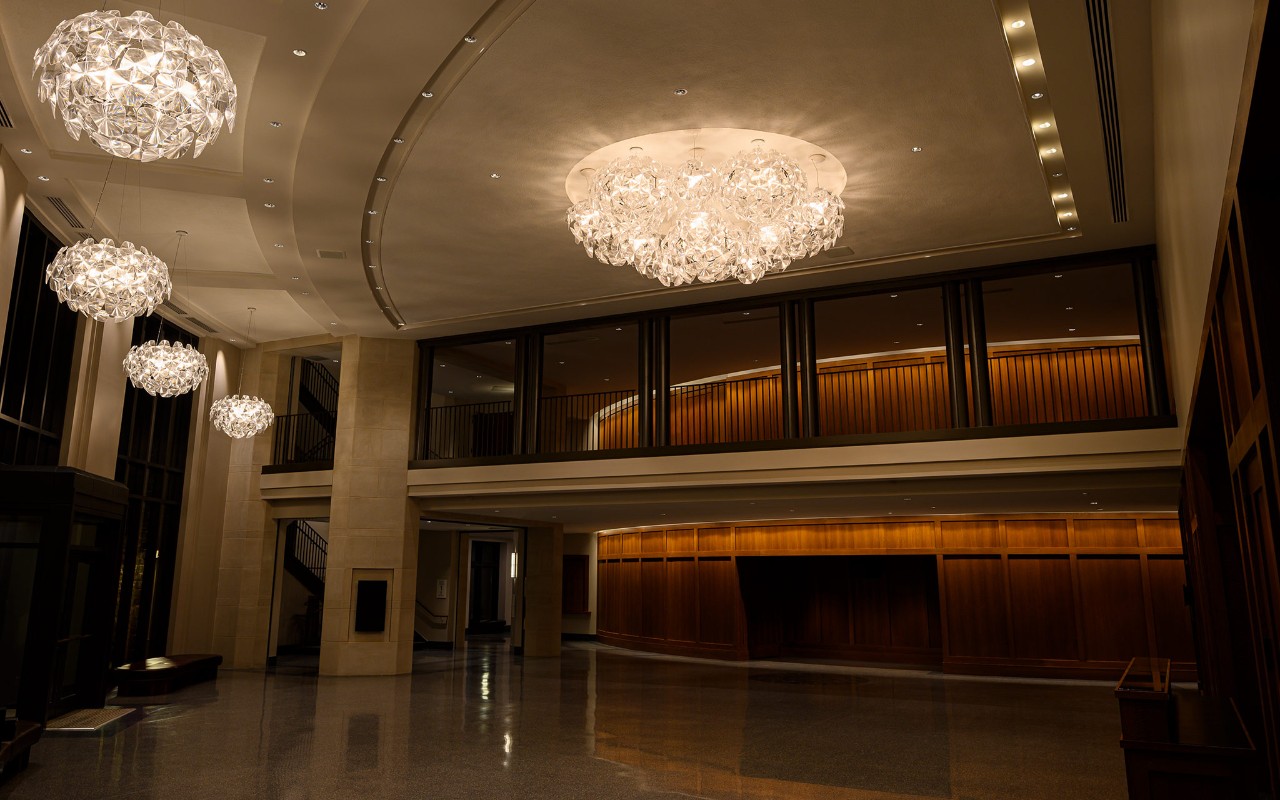
It’s
Showtime!
Showtime!
Shining a light on the
Mullen Center for the Performing Arts
In two short years, the John and Joan Mullen Center for the Performing Arts has come alive with creative energy. “You might hear Mozart’s Requiem being rehearsed in the hallway as you enter a theatre to watch a play being directed by a Pulitzer Prize-winner—and down the hall, graduate students are loading into our lab space for a thesis project,” says Valerie Joyce, PhD, ’92 CLAS, ’95 MA, chair and associate professor of the Theatre and Studio Art Department. “It’s pretty exciting. The Mullen Center presents an opportunity for performers, administrators and scholars to collaborate and cross-pollinate.”
After years of planning, collaboration and fundraising, the Mullen Center opened in spring 2020 with little fanfare due to the COVID-19 pandemic. But even without a big ribbon-cutting ceremony and splashy black-tie gala, it has been a cause for much celebration as a center that is already advancing the performing arts and academics at Villanova.
“Executive Director Parris Bradley ’16 MPA describes the Mullen Center as a lighthouse for the arts at Villanova. It’s an apt analogy, considering all who have been attracted to the site with its beautiful stone façade and glowing chandeliers centrally located at the corner of Lancaster and Ithan avenues.
The 2021–22 academic year marked the return of in-person performances. For those who work in the Mullen Center, it has been a joy to see it bustling with life and energy every day of the week. This year, they hosted more than 150 successful performing arts events, on top of hundreds of classes, trainings, lectures, meetings, rehearsals and other activities.
The Mullen Center is being utilized by a wide cross-section of the on-campus community and visitors and, in turn, exposing them to the wealth of performing arts experiences right here on campus. And in the eyes of University President the Rev. Peter M. Donohue, OSA, PhD, ’75 CLAS, that’s always been the goal. “For a university of Villanova's caliber not to have a facility dedicated to the performing arts was a disadvantage. It was the one missing piece for Villanova as a national university,” says Father Peter. “Now, with the Mullen Center, we have the flexibility and the possibility of hosting various events and types of performances. The variety of things we can do in the building is what I enjoy most about the new space.”
“ It needed to be a space where all of Villanova’s varied and various performing arts groups could flourish. ”
- The Rev. Peter M. Donohue, OSA, PhD, ’75 CLAS
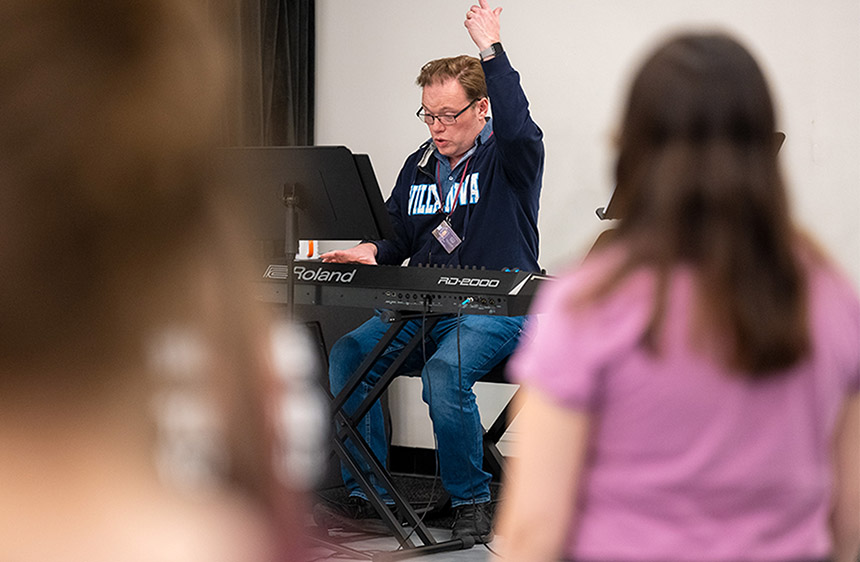
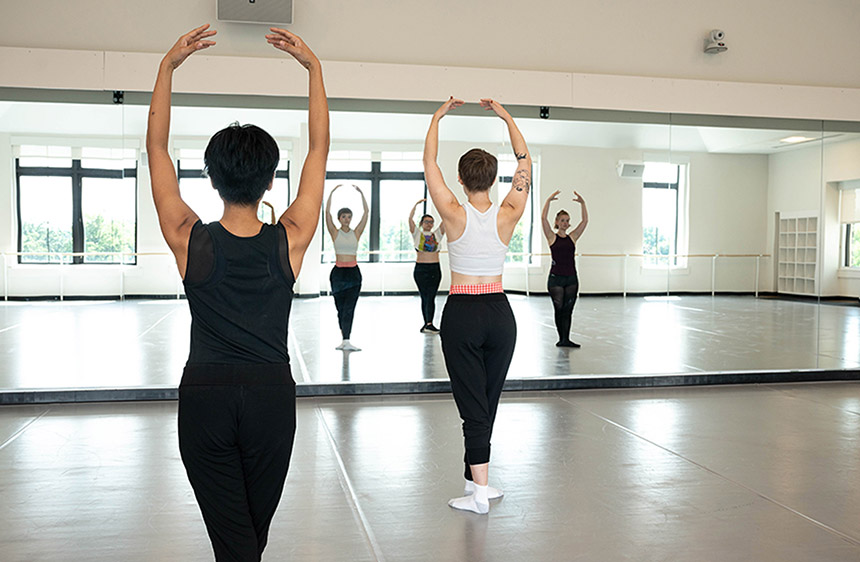
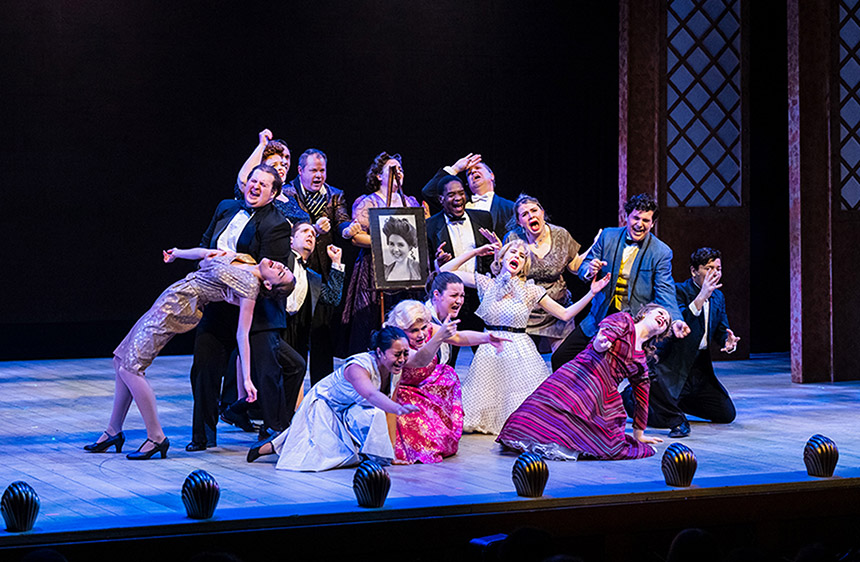
If You Build It, They Will Come
Since the day Father Peter returned to his alma mater as chair of the Theatre Department in 1992, he dreamed of enhanced resources. With approximately 700 undergraduate and graduate students involved in more than 20 performance-based student groups, he was determined to give the University what it did not yet have: a cutting-edge performing ats facility.
Throughout the years, Father Peter cultivated that dream and began touring other performing arts centers across the country and speaking with their staff to determine how the ideal Villanova performing arts space would take shape.
His vision was to create a place that would be, in his words, “more than just a theatre; it needed to be a space where all of various and varied Villanova’s performing arts groups could flourish—a place where they can rehearse and perform and showcase their talents.” He also wanted an academic building reflective of Villanova’s pedagogy, with performance spaces, studios and classrooms to advance education and artistic expression.
It was a bold plan built on hard work and dedication—and funded entirely through philanthropic support. The Villanova community responded. Funding for the $60 million Mullen Center project came from more than 750 individual donors. The building is named in recognition of a $20 million leadership gift from John and Joan Mullen ’95 CPS. The Topper Theatre—a 400-seat proscenium-style theatre—recognizes a leadership gift from Maureen ’77 CLAS and Joseph Topper ’77 VSB, a former chair of Villanova’s Board of Trustees.
The vision and work came to fruition as the 85,000-square-foot center opened. It features world-class spaces to advance education and artistic innovation at Villanova. It contains three theatres, a dance studio, scene shop, costume shop, rehearsal room, dressing rooms and green rooms. There are five classrooms in all—three that are designed for acting, dancing and singing, along with two multifunctional classrooms, which can be used for courses in subjects ranging from English Literature to Public Administration. In addition, there are practice rooms, a box office, three lobbies and a roof terrace that’s perfect for receptions and offers a fantastic skyline view of Villanova’s campus.
“We designed this building to be professionally outfitted to make the imagination limitless,” says Bradley. “The Mullen Center provides all of the technical expertise, so there’s a lighting and sound designer, ushers and box office staff, and whatever additional support is needed to help bring our users’ concepts and dreams to reality.”
“ The Mullen Center is an opportunity for performers, administrators and scholars to collaborate and cross-pollinate. ”
- Valerie Joyce, PhD, ’92 CLAS, ’95 MA
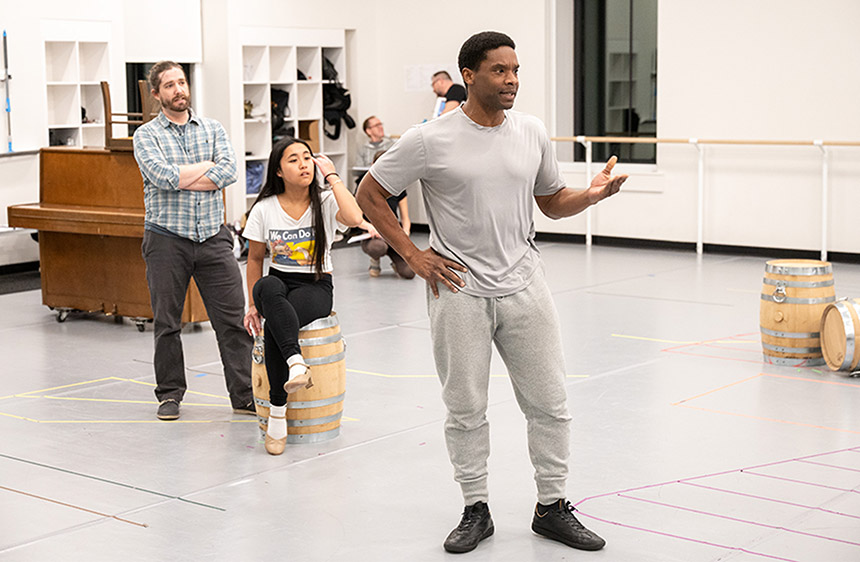
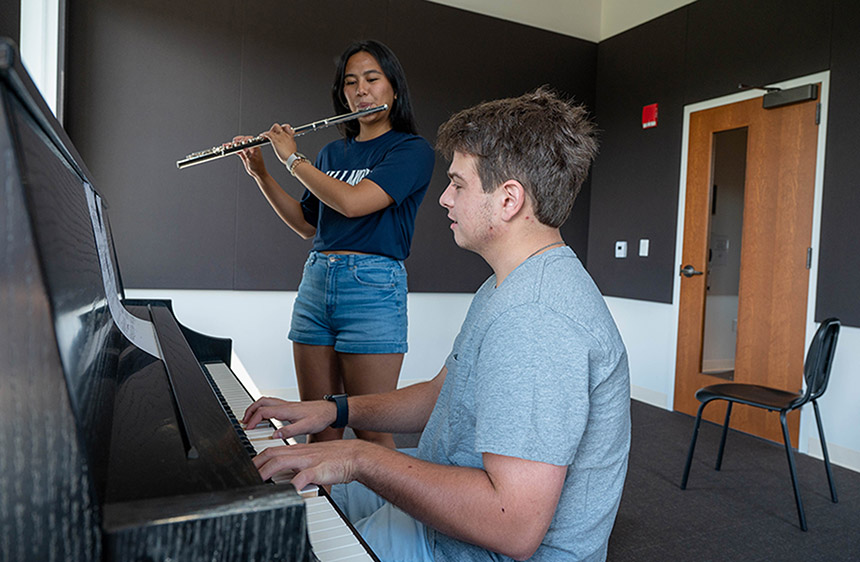
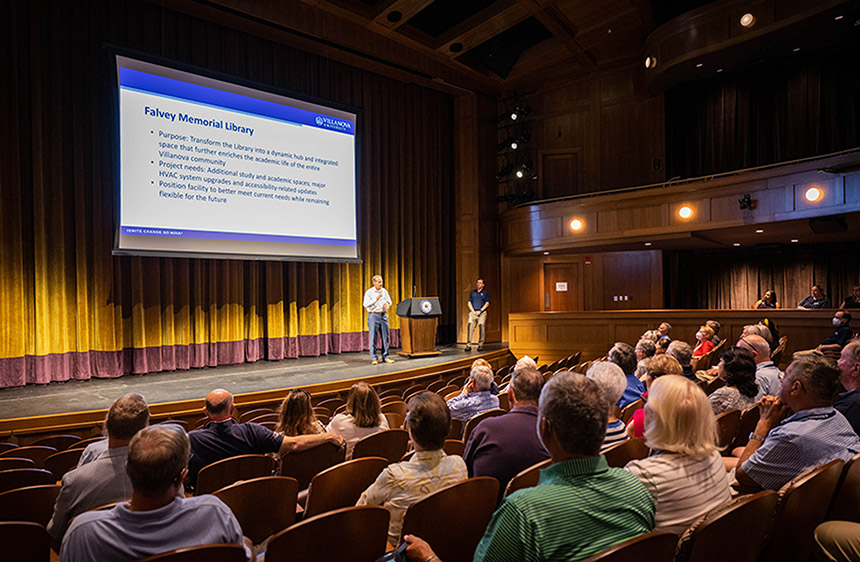
Something for Everyone
Always intended for use by the entire Villanova community, the inviting façade and state-of-the-art facilities have quickly made the Mullen Center a popular attraction on campus.
Lights, camera, action.
Members of the Athletics Department have filmed several videos for its varsity sports programs using the center’s fog machine and rock-and-roll lighting.Working it.
A work-study staff of 20-some undergraduates—who are not strictly performing artists—do everything from ushering to running lights and tech to building scenery and props.Celebrate good times.
One of many special events to be held on the third-floor Belle Masque rooftop terrace was hosted by the M. Louise Fitzpatrick College of Nursing to honor the remarkable health care providers who worked to keep the campus community safe throughout the pandemic.
Pitch perfect.
The Villanova Faculty-Staff Choir comes together for weekly rehearsals in the Dwyer Family Foundation Choral Room, which, among its many features, includes a Steinway Model M baby grand piano.
MARK YOUR CALENDARS
The Mullen Center for the Performing Arts has a busy slate of activities lined up for the 2022–23 academic year. To view a complete calendar of the music, performances and lectures on tap, visit villanova.edu/boxoffice.
Academics Take Center Stage
“Phenomenal” is the word Dr. Joyce uses to describe the new home of the Theatre Department. As the department chair since 2017, she oversees both its production arm and academic arm, which were divided across campus prior to the Mullen Center’s opening. “Being under one roof gives us so many opportunities,” she says. “And, from an academic perspective, the classrooms are fully outfitted with everything we could have wanted, making a world-class educational experience available to our students.”
Teaching classes in the new Mullen Center dance studio has been a game-changer (and mood lifter) for Barby Hobyak-Roche ’88 CLAS, adjunct professor of Dance, who describes the space as hitting the mark in myriad ways. “The large studio allows dancers to move with abandon and expand with intention, the mirrors allow for self-correction, and the Marley flooring is wonderful for a variety of styles,” she says. “Dancing in there, with the sunlight streaming in through the windows during the day and the sunsets at dusk, it's like heaven.”
Michael Hollinger ’89 MA, artistic director of Villanova Theatre and a professor who teaches courses both in Music and Theatre, agrees with the positive assessment. “The Mullen Center is such a wonderful environment for teaching,” he says, noting that engaging with his students who take Songwriting: Words & Music and The Beatles: Song by Song in the Dwyer Family Foundation Choral Room has improved merely by the nature of the design of the classroom.
“The risers and curved seating arrangement allow for a great visual connection with students,” says Professor Hollinger. “And the full white board gives me plenty of real estate to notate musical passages and write detailed lecture notes.”
The Villanova Theatre Department offers a variety of courses in the arts and three minors to Villanova's undergraduate students. All of these, with the exception of studio art, are now located in the Mullen Center. Villanova’s Master of Arts program is one of only a handful of MA theatre programs in the US. Dr. Joyce, who describes herself as “homegrown” as a proud graduate of that program, has been directing, designing and performing on stage at Villanova Theatre for nearly 30 years.
Asked what makes Villanova’s Graduate Theatre program stand out from the others, she points to the equal emphasis placed on both academic work and practical experience. “The words that we use are scholar-practitioner, so the theatre scholar and the theatre practitioner are melded at all times in everything we do,” explains Dr. Joyce.
This model is reflected in the faculty as well, who are both academic scholars and working artists. “These teachers are some of the best,” says Sheldon Shaw ’23 MA, who came to Villanova’s Graduate Theatre program after working as an actor and playwright in New York City. “My acting teacher, (Associate Professor) Edward Sobel, was nominated for a Tony. I’m studying under (Associate Professor) James Ijames, who just won a Pulitzer Prize for Drama. They know what they are talking about.”
Theatre students gain valuable insight into their fields and experience to help them succeed after graduating. “It gives our students an edge because they actually know how to produce theatre,” says Dr. Joyce. “They come out of the program with all of these applicable skills that can get them jobs, whether it’s hanging lights or as a stage manager or dramaturg.”
While plans for an in-person 2020–21 theatre season had to change because of COVID, the Theatre Department went into overdrive to stage performances that they filmed with the utmost care and caution. “It was fascinating watching the department pivot,” says Alison Scaramella Baker ’22 MA. “They took this challenge and turned it into a new opportunity.”
“ It’s a space that actually inspires you to keep reaching and going farther. ”
- The Rev. David Cregan, OSA, PhD, ’89 CLAS
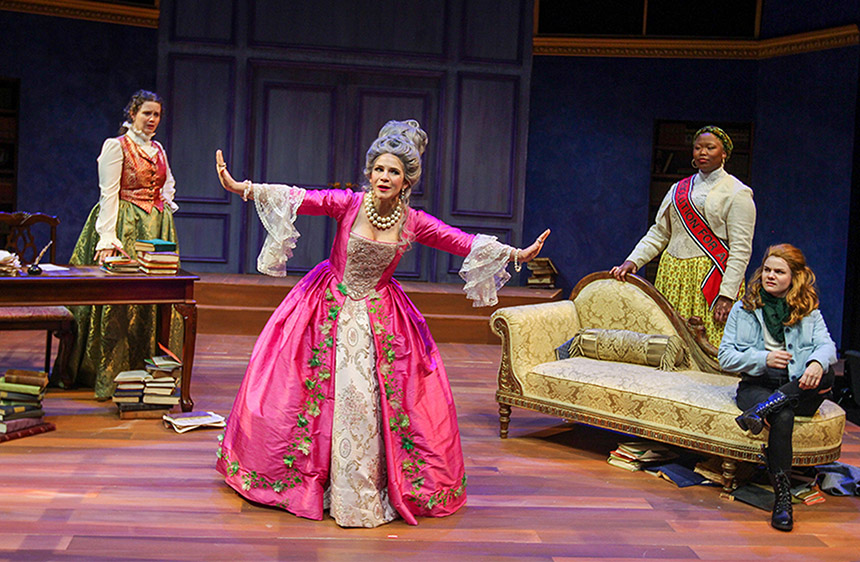
The Show Goes On
Thanks to a loyal subscriber base and new visitors eager to see the Mullen Center and immerse themselves in live productions again, there was no problem filling Villanova Theatre’s comfortable seats throughout its 2021–22 season. The season ended on a real high note when Curtains generated standing ovations from sold-out crowds. It was the first show ever to be staged in the 400-seat Topper Theatre, the largest of the Mullen Center’s three theaters. “It was thrilling,” says Father Peter of his experience directing the musical whodunit in the building he painstakingly brought from concept to reality.
This marked the Barrymore Award-winner’s return to the director’s chair for the first time since 2012. And he didn’t disappoint—delivering a high-energy show that made the most of the bells and whistles now at Villanova Theatre’s disposal, including a fly system and 30-member orchestra pit. The cast and crew drew from the talents of Villanova’s staff, faculty, alumni, and graduate and undergraduate students. In the starring role originated by David Hyde Pierce on Broadway was the Rev. David Cregan, OSA, PhD, ’89 CLAS, former Theatre Department chair and current associate dean of Academic Affairs and Strategic Initiatives for the College of Professional Studies.
Father Cregan, who also served on the Mullen Center design committee, partially attributes the success of Curtains to everyone rising to the occasion of the building itself. “It’s a space that actually inspires you to keep reaching and going farther,” he says. “Whether we were in the dance studio with all the mirrors, or in the choral room with the grand piano, or on stage with the orchestra pit and theatrical lighting, it brought everything up to a new level.” He also credits Father Peter for the planning, talent and leadership it took to elevate arts and arts education at Villanova. “As a director, he’s got the vision,” says Father Cregan. “He’s unwavering in his energetic investment in making the show, and Villanova, the best that it can be.”
For his next act, Father Peter is already thinking of staging a reunion of Theatre alums in a big musical production on the Topper stage, but that would be further down the line. For now, he’s looking forward to the creative collaborations that are newly possible because Villanova’s academic programs and student groups in the performing arts are finally together in one place. “In time, our graduate students and undergraduate theatre groups will start doing more things collaboratively and utilize each other’s talents in different ways,” says Father Peter. “It’s fun to see the whole thing blossom.” ■
Highlights at the Mullen Center
“
Movable tables and chairs allowed my classes the freedom to configure our location in the room for whatever we needed to do, whether it was acting out a scene from a Shakespeare play, small group scholarly research or literally taking sides during a live political-economic debate.”
- Kaley M. Carpenter, PhD, associate teaching professor in the Augustine Culture Seminar program and Lawrence C. Gallen Fellow in the Humanities
“
Our Winter Concert in 2021 was the first concert the Villanova Band performed in the Topper Theatre. After we played our first few notes in the venue, the look of excitement on everyone's face was unforgettable—the acoustics and sound in the theatre were so impressive it took us by surprise!”
- Rachel Westcott ’23 CLAS
“
I got to play Marie Antoinette, who is just this larger-than-life character to sink my teeth into. I had this high gray wig and massive hot pink period dress that the Costume Shop custom-made for me and I’m like, ‘How much would this cost if I were to buy it in the real world?’ Turns out I was wearing a $20,000 gown. It was just beautiful and really transformed my performance.”
- Alison Scaramella Baker ’22 MA
“
Performing in the 2021 production of White written and directed by (Associate Professor) James Ijames was unique because it was almost like a workshop, with things changing and improving throughout the weeks of rehearsal. Whole scenes were added, lines adjusted and it even had a brand-new ending. I believe it made me a better performer and director in my own right.”
- Veshonte Brown ’22 MA
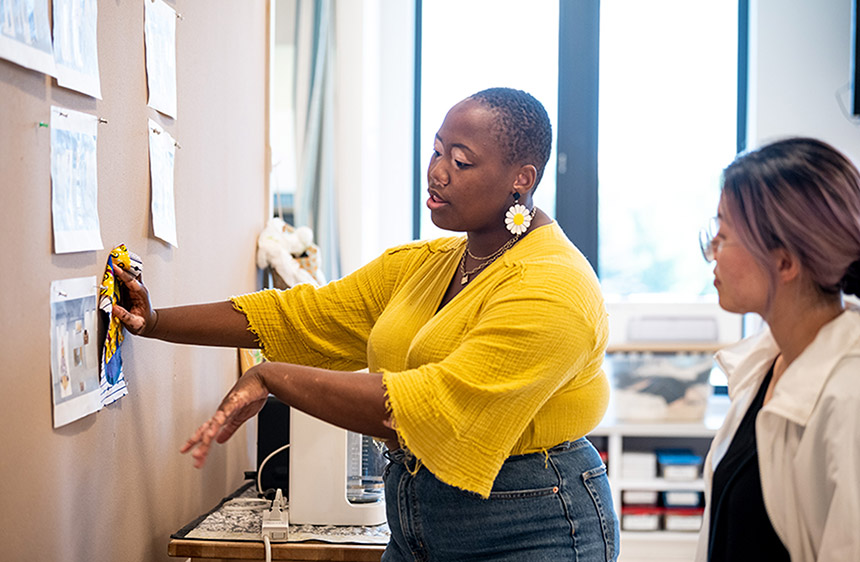
Tailor Made
Veshonte Brown ’22 MA, a graduate assistant in the Costume Shop, shares some of the detailed preparation that goes into creating the perfect looks for the productions Villanova Theatre puts on each semester.
What’s your role in the Costume Shop? I have a variety, including assistant to the designer, stitcher and craftsperson. I collaborate with the work-study students, which is cool because they tend to have been in the shop longer than the graduate students. They are whip-smart and bring a level of professionalism and expertise that is incredible.
How do you produce a costume? A large part of the process is focused on bringing paper designs into real life. There are a couple of ways to do that: Sometimes we make garments from scratch, and sometimes we buy something ready-made and alter it to better fit the design and performer’s body.
What is your favorite part of your job?
It’s a tie between sewing and research. Sewing is like sculpting, making something from these large bolts of cloth. And I love researching clothing from different time periods. I always try to expand my knowledge of silhouettes, fabric innovations and how pop culture impacted what people wore.
Do you have a favorite design?
We created a one-of-a-kind gown for the Marie Antoinette character in The Revolutionists. I researched and experimented using our brand-new embroidery and cutting machines to make a trailing vine design and 3D organza flowers. There was a lot of trial and error but the designer gave me full reign to make it happen. It’s an unbeatable feeling when, because of your work, something beautiful happens.
NEXT IN FEATURES
Retiring as a Villanova coaching legend, Jay Wright shares his game-changing lessons